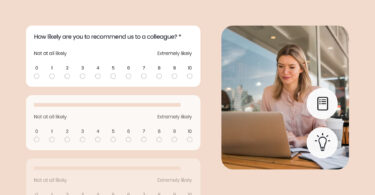The key to running a great business is keeping your customers happy. Of course, that’s easier said than done. There’s a reason why 50% of new businesses fail within the first five years. So what’s the secret to long-term success? It’s understanding and anticipating your customer needs. That brings us to the voice of the customer (VoC).
- Voice of the Customer Examples
- Best Practices for Voice of the Customer Programs
- Voice of the Customer Techniques
- How Voice of the Customer Helps Your Business
- Biggest Voice of the Customer Mistakes
- Using Voice of the Customer Tools
Frequently asked questions about the voice of the customer
Voice of the customer is a business term describing your customer’s experiences and expectations for your product and/or services. A voice of the customer program is designed to capture quantitative and qualitative feedback in order to make improvements to business operations.
Voice of the customer is important for a simple reason: Constructive criticism is part of becoming a great business. It’s possible for businesses to deliver a completely different experience from what their customers are looking for.
Voice of the Customer Examples
Let’s go through a couple of examples that can help you build your own Voice of the Customer program.
Dell Technologies
You’ve probably heard of Dell Technologies, the company that sells computers, servers, and network security solutions. What you might not have known is that back in 2005, Dell was facing a crisis. The blogger Jeff Jarvis wrote a post called Dell Lies. Dell Sucks complaining about the company’s practices.
So how did Dell escape having their reputation destroyed? They used the voice of the customer. The company even launched a website (now defunct) called IdeaStorm, meant to be a place where customers could submit complaints. The company launched a survey program that captured 2 million survey responses a year. This feedback helped Dell build better products and provide better customer experiences.
Dell even had a dedicated “Voice of the Customer” team that spent time listening to feedback and suggesting improvements to the product. Nowadays, Dell is doing just fine. The company got more than $90 billion in revenue in 2019.
Lessons from Dell
If your business is getting bad press and negative customer feedback, it isn’t the end of the world. It’s just a sign that you need to listen to the voice of the customer. A bad reputation can be saved when a business makes a sincere effort to listen to customer feedback.
You might be wondering if your business can replicate Dell’s strategy. Chances are that you don’t have the resources to set up your own website that exclusively dedicated to customer complaints. It’s important to remember that the incident took place more than a decade ago. Nowadays, there are software solutions that can help businesses better understand customer experience. More on that later. First, let’s go through one more example of a successful voice of the customer program.
Blaze Pizza
Blaze Pizza was in the midst of rapid national expansion. The company was opening up a new location every 5 days. In order to maintain a quality customer experience in the midst of this rapid expansion, Blaze Pizza needed to keep a close eye on customer feedback throughout the country. Obviously, it’s not easy to collect feedback from customers located all over the United States.
Blaze Pizza used Birdeye in order to track review sentiment from all locations. If a location had reviews that were too low, the company would look at categories that customers were mentioning in review text such as “wait time”. They would use this information to make improvements to individual locations.
Lessons from Blaze Pizza
While people typically think about surveys when they think about customer feedback, it’s important to realize that there are multiple different channels for collecting feedback, and paying attention to all of them.
Channels like reviews provide important insights that businesses can use to make improvements. While reviews don’t need to replace surveys entirely, reviews do provide important data on customer satisfaction. So make sure that your voice of the customer program uses multiple channels to get a holistic view of overall customer experience.
Voice of the Customer Best Practices
Here are some best practices for collecting the voice of the customer.
Make Collecting Feedback Part of Your Business Processes
In order to understand the voice of the customer, the act of collecting feedback needs to be built into the organization’s culture from bottom to top. This means sending out surveys regularly or asking for a customer review every time a customer is helped.
One simple way that Birdeye customers do this is with the review leaderboard. The leaderboard helps create a competitive environment where employees strive to be on the top.
Analyze Customer Feedback
It’s not enough to just collect customer feedback. Once you have customer feedback, Understanding customer feedback is about finding the areas of your business that customers care about the most.
Measure the Impact of Changes
Once you make a change to business operations, make sure you measure the impact that this has on your customers. Keep track of customer sentiment in online reviews and customer surveys. If it seems that customer satisfaction has gone down after you made the change, it might be best to roll back what you’ve done and look for different solutions.
Track the Right Metrics
Setting goals for your business and tracking metrics like customer satisfaction can help you build a stronger customer experience. Maybe you could aim to have a high NPS or a higher overall star rating for each one of your locations. Of course, make sure that you’re not only focused on metrics (more on that later).
Monitor Feedback Constantly
While it can be great to hit a goal in an important metric, it’s important to remember that you can’t stop monitoring feedback when something like this happens. Monitoring feedback constantly opens the door to constant improvement.
Open Communication Channels
Make sure that it’s easy for a customer with feedback to reach out to your business. The easier it is for a customer to talk to you, the better the feedback that you’ll get. So what’s the best way to get a customer to reach out? Use webchat aka website chat. Studies show that customers prefer website chat to phone or email.
Voice of the Customer Techniques
Here are a few ways that you can start capturing the voice of the customer.
Focus group discussions
A focus group is a small group of people, preferably in your target audience, that you can bounce ideas off of. A focus group is hard to get together, but it’s a great opportunity for in-person feedback
While focus groups work well for some companies, we are not too fond of them. One problem with focus groups is potential bias. Some focus group participants may not feel comfortable expressing their true opinion around total strangers. Typically, you will need to pay focus group participants for their involvement as well.
Customer surveys
Surveys are a great way to collect feedback. Unlike focus groups, surveys can be sent with low cost and low effort when a business uses effective survey tools.
However, surveys need to be part of a larger voice of the customer strategy. It’s easy to make the data from surveys fit your pre-existing assumptions of what customers really want.
That’s why it’s important to listen to what your customers on other mediums such as…
Customer Reviews
There’s one place where customers are already leaving feedback about your business: business review sites like Google. Looking at these customer reviews can give you a great idea of where your business needs to improve.
Of course, in order for customer reviews to provide effective feedback, it’s important to make sure that you’re soliciting reviews regularly. Without solicitation, only customers who feel that they had a strong negative experience will be motivated to leave reviews.
Social Media Feedback
Review sites aren’t the only place where customers are talking about your brand. Customers are talking about your services on sites like Facebook and Twitter.
It can be hard to find every mention of your brand on social media. That’s why it can be worth it to invest in a social listening tool. A tool like Birdeye can monitor mentions of your brand on social so that you know right away when someone is talking about your business.
Talk to Customers
Try to schedule a phone meeting with one of your customers to see what they like and dislike about your business. Asking a customer where you could make improvements can be a great way of collecting feedback, but it does run the risk of you making decisions based on anecdotes. Talking with customers is best complemented with other strategies like surveys and review insights.
How Voice of the Customer Helps Your Business
Here are a few ways that a voice of the customer program can help your business.
Create Better Marketing
With a voice of the customer program, you’ll be able to discover what customers love about your business. You can use some of the phrases that your customers are using to describe your services.
Maybe your customers say that your product “works like magic”. Try using this same language in your Facebook ads and email marketing. This can help you better connect with your prospective customers.
Customer Experience
Remember, having a customer experience that doesn’t match customer expectations can quickly lead to problems for your business. Remember our Dell example from earlier? Angry customers can take to the Internet and leave negative reviews, turning away potential customers for your brand.
The best defense against this is to make sure that you’re exceeding the expectations of your current and future customers. Use customer feedback as an opportunity to improve your overall customer experience and prevent this from happening.
Develop New Products and Services
A voice of the customer program can also help your business expand into products and services that your customers want. Maybe you’re a pizza parlor who finds out if your customers want to drink kombucha in your store. That may give you the idea to introduce the drink as an option.
Biggest Voice of the Customer Mistakes
There are a few mistakes that businesses make when implementing voice of the customer programs that lead to suboptimal results. Here are a few.
Focusing Only on Metrics
Everyone wants to be able to show the rest of the company improvement, so it’s easy to brag to the company about an improvement in Net Promoter Score. While it’s a great feeling to see these kinds of metrics go up, it’s important to take a wider view.
While knowing your Net Promoter Score and overall star rating is great, being focused only on the numbers can give you a limited view of what your customers are thinking. That’s why it’s important to look at things like review text- this can help you to see the exact areas where customers want to see improvement.
Never Checking-In with Customers
Sometimes, a customer may be more honest in an anonymous survey. But most of the time, customers that come to you with feedback and complaints are looking for a response.
When customers give feedback, they want to know that their comments are being heard. If you take steps to change business operations based on customer complaints, reach out to the customer and let them know. Chances are that they’ll be delighted to hear that their feedback has been taken into consideration.
Wait Too Long to Distribute Feedback
Imagine that you’re an employee that gets data about customers’ Net Promoter Score falling from three months ago. While this data shows that something has gone wrong, chances are that the employee might not remember all the things that went wrong.
Effective voice of the customer programs make sure that the data is up-to-date and available at all levels of the organization. Make sure that your employees are aware of how customer satisfaction is changing on a regular basis.
Using Voice of the Customer Tools
A tool like Birdeye can help you to understand the Voice of the Customer. Here’s how.
Monitor Reviews Across the Internet
It’s tough to monitor reviews about your business all over the Internet. Birdeye makes it easy. In the Birdeye dashboard, you can monitor and respond to reviews in over 150 sites, including Google and Facebook.

Send Customer Surveys
Want to start sending customer surveys? Birdeye allows you to send fully-customizable customer surveys that customers can open on email and text. You’ll be able to analyze the results in the Birdeye dashboard.
Get Insights from Customer Reviews
While it can be hard to sort through hundreds of reviews and see what improvements need to be made, software can make the job easy. With Birdeye’s Natural Language Processing engine Athena, it’s easy to get insights from review text.
Get Started with Birdeye
Want to start collecting more customer feedback? Birdeye can help. More than 200,000 businesses use Birdeye to collect feedback, analyze data, and improve customer experience.
Here’s how Birdeye can help your business collect customer feedback.

Originally published









